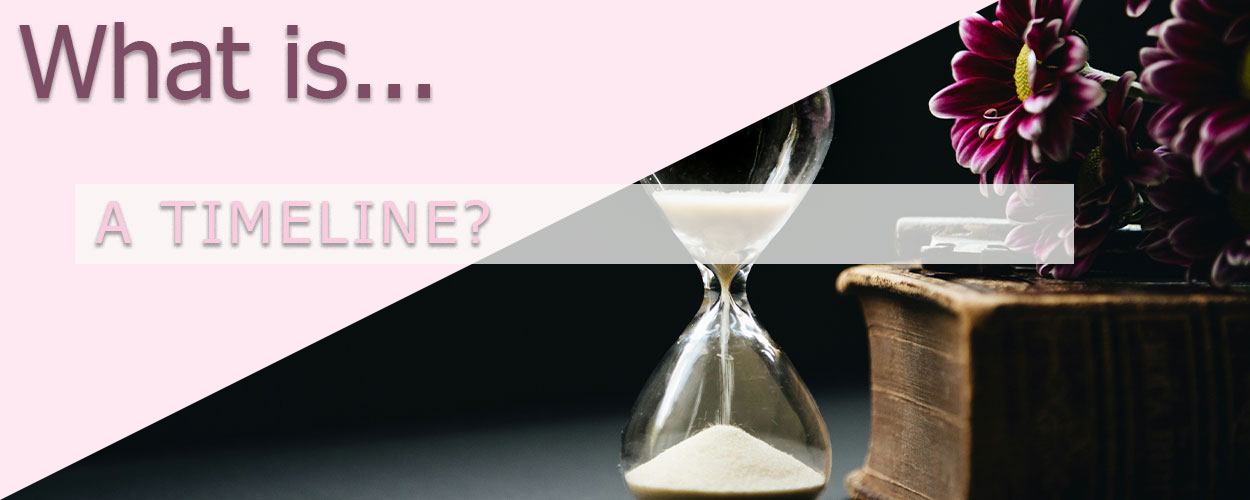

Posted: March 26, 2024
When writing your novel, there are countless methods, tips, and tricks that can ease your journey. Creating a timeline for the story is one way to ensure that dates and facts stay consistent. So, what is a timeline?
Put simply, a timeline is a chronological arrangement of events in the order of their occurrence. This is entirely different from a book’s plot, which, in turn, is different from an outline.
As opposed to plot, which also lists the events of the story, the timeline lists events purely in chronological order. The timeline often even starts before the start of the book, as things will likely occur during the story that take place before chapter one.
While both a timeline and the plot of your book are both written in statements of pure fact, a timeline doesn’t care about the structure of the book. You will include all secrets and plot twists and details in a timeline, whereas your plot will be ordered in a sequence that will most effectively portray the details. The plot will allow twists and turns, hidden information, and mysterious circumstances that a timeline does not. The plot allows characters to hide behind a mask, whereas a timeline will show their motivations plain and clear from their backstory to their demise (should that be included).
[Related Article: What is Plot?]
In simple terms, a timeline is part of an outline. It’s not entirely necessary to create a timeline if you have your plot laid out and your characters known; it’s just another helpful tool.
An outline encompasses all things that make the setup of a novel. Though this does not include most research documents, it includes the book’s timeline, plot summary, character bios, and other documents arranging the book’s contents.
[Related Article: What is an Outline?]
For some people, creating a timeline won’t have any added benefits, as their minds do not work in such a straightforward way. Creating documents and organizing research papers isn’t for them. However, it is still quite useful. Some benefits include:
Timelines are treasured gold for organized writers and people whose minds flourish with these graph-and-chart documents. A lot of the time, they can also allow a writer to more easily plan for better Red Herrings, unexpected reveals, and mysteries—though only in conjunction with other documents or with the writer’s own mind to keep track of how and when this will be done.
Your timeline is not meant to be fun to read. It can be, since it’s full of secrets, but it is merely a list of dates and events with the barest details. Character birthdates to keep track of ages, events in those characters’ lives, seemingly obscure details that’ll be crucial later on. Important plot points—incidents, battles, disasters, first meetings—will also be there.
There are a few different ways to include all this information.
Your first option would be simply to lay out the information as it comes. You may start with an idea for the beginning of the story, or imagine a scene that will come in the future or the backstory of a character you want to introduce. As ideas come for the story, insert them into the timeline. You can always move things around if the dates need to change.
The second is to follow the plot. You’re writing the story or outline alongside writing your timeline, and as you write down the plot events of the story, you create a separate list in which the events are ordered chronologically. You’ll likely add to this later on when you’re actually writing the story.
The third option would be to go through each character’s arc. If you already have your characters created, you can go through the life story of each of them—if you’re the type to be super organized, you can even highlight them each a different colour to keep track. Once your first character is complete, you would move onto the next, including their interactions with Character 1, and so on. This may also help in spurring ideas.
You may have a fourth option that I haven’t listed here, and if that works for you, right on! One thing to remember is to try and keep your timeline events as brief as possible—you’re not writing the novel here, after all!
Top 10 Tips for New Writers
Top 10 Tips for All Writers
Top 10 Tips for Writing Captivating Stories
Writing Good Characters
Writing Compelling Villains
Pixar’s 22 Storytelling Rules
What is a First Draft? [writing]
What is Plot? [writing]
What is an Outline? [writing]
What is Genre? [writing]
What is Character Building? [writing]
What is Character Development? [writing]
What is Worldbuilding? [writing]
What is Beta Reading? [review reading — pre-launch]
Tigerpetal Press is a small book press dedicated to publishing local authors and poets.